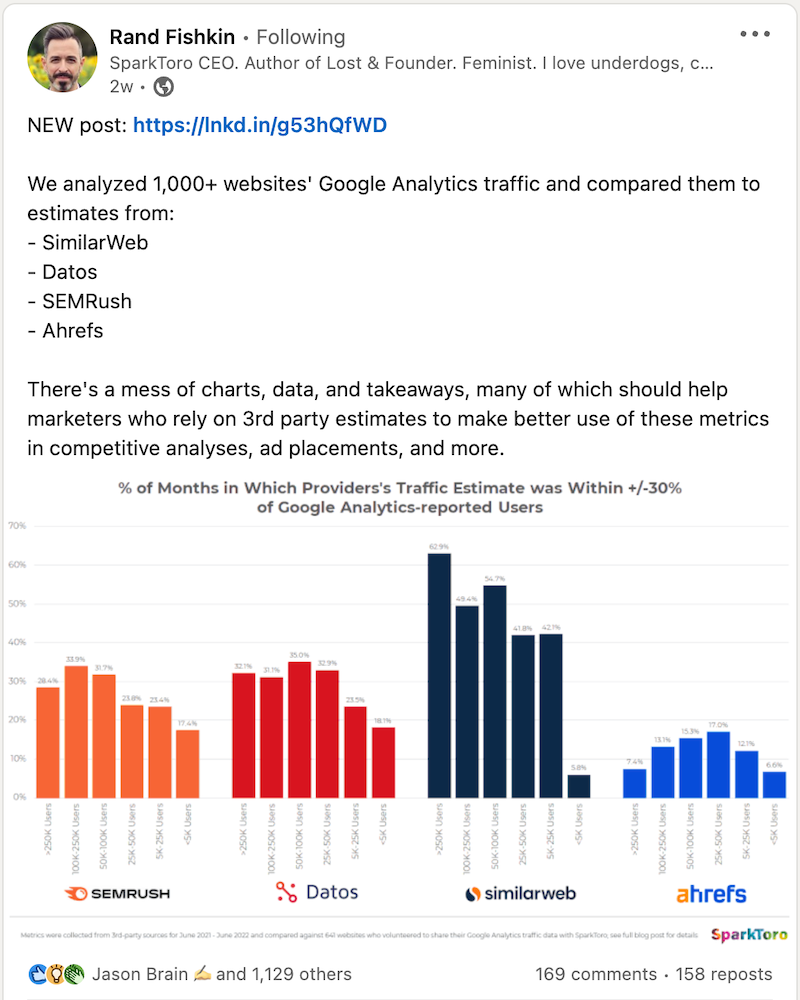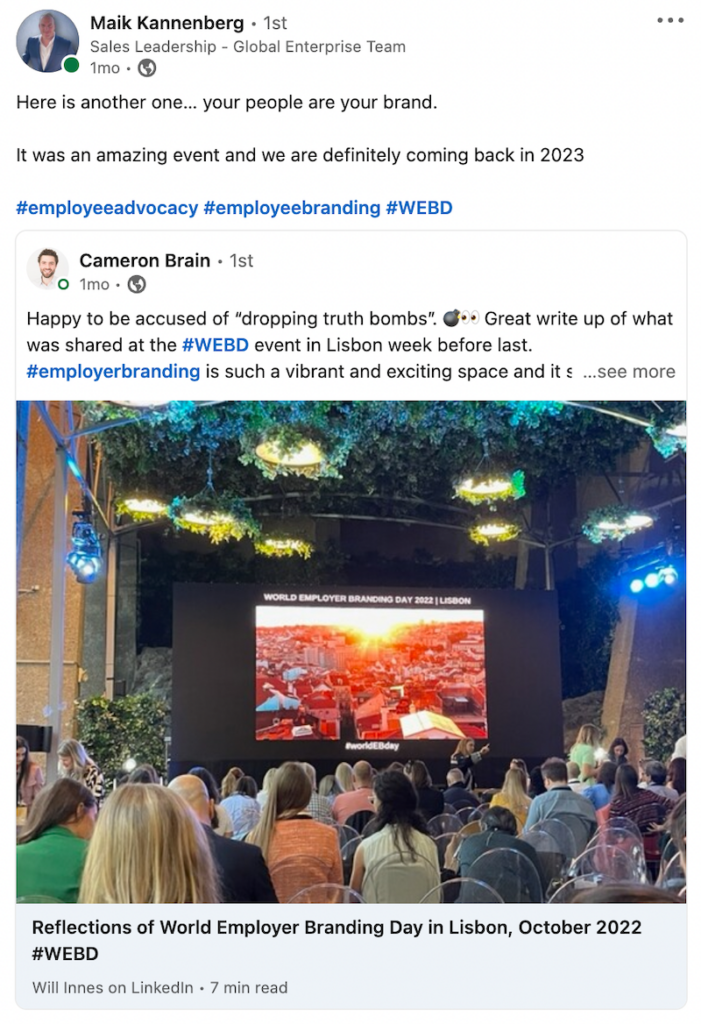Whether you cringe at the term “thought leader” or not, harnessing the power of thought leadership can be a goldmine for your company.
It’s why many organizations have a thought leadership strategy in place or are thinking about how to leverage their internal expertise further.
And it’s even more important today since standing out among a sea of brands, products, and channels is insanely challenging. Plus, you need an effective way to distribute insights and messaging to where people regularly consume information.
Below, I’ll get into the goal of thought leadership, who’s involved in it today, and some tactics to get your thought leadership strategy headed in the right direction. Let’s dive in!
What’s the Goal of Thought Leadership?
Before maximizing who’s involved and the tactics, you need to understand the goal of exploring thought leadership.
While your company may have a slightly different vision than the next, most thought leadership strategies aim to accomplish the following:
- Help your brand create a unique point of view in your specific market.
- Establish you and your brand as the go-to source of industry information and trends.
- Organically improve your company’s reputation and increase trust in it.
- Grow marketing and sales results over time through consistent content.
- Give your organization an edge and competitive advantage.
Don’t forget the thought leadership data.
There’s plenty of data out there that illustrates the impact a thought leadership strategy has on business. Here are just a few quick highlights:
- 54% of decision-makers — and 48% of the C-Suite — say they spend more than an hour per week reading and reviewing thought leadership.
- 65% of buyers say thought leadership significantly changed the perception of a company for the better.
- 63% of buyers say thought leadership is important in providing proof that an organization genuinely understands or can solve specific business challenges.
- 90% of decision-makers say that referrals from people they know and respect will be moderately, very or extremely effective in earning their attention and purchase consideration.
Who Can Establish Thought Leadership Today?
Any company in any industry can establish thought leadership.
Certainly, some industries are more competitive and others are saturated, but you can still win and stand out as THE trusted brand in your niche.
And here there are three specific groups of people within the organization from which thought leadership can emanate:
- Executives
- Subject Matter Experts
- Employees
There could be some overlap among these groups of people, but it’s the best way to think about your internal thought leadership.
“Thought leadership is one of the most effective tools an organization can use to demonstrate its value to customers during a tough economy — even more so than traditional advertising or product marketing, according to B2B buyers.” – 2022 B2B Thought Leadership Impact Report by Edelman and LinkedIn.
Executives
Leaders or executives within an organization are no-brainers when it comes to helping establish thought leadership. People gravitate toward executives’ content and are already interested in what they have to say.
Many businesses today have grown significantly in brand awareness and revenue just because their leaders are highly active on social media, on podcasts, at events, and more. In other words, they’re regularly sharing their knowledge and innovative ideas.
A few such execs I can think of right now include:
- David Cancel, Founder of Drift
- Chris Walker, Founder/CEO Refine Labs
- Rand Fishkin, Founder/CEO SparkToro

Subject Matter Experts
A subject matter expert (SME) is a person who’s an authority in a particular field. These individuals are sought out to offer insights, solve specific problems, or meet challenges unique to their expertise.
It’s very similar to how we define a thought leader — just a different term that’s often used interchangeably.
An executive can be a subject matter expert as well, but an SME can also be someone else within the organization with highly specialized knowledge. This is why I separate them out.
For example, here at EveryoneSocial, we have a few subject matter experts that are on the frontline of sales demos and implementation kick-offs of our product, but are not in the C-Suite.

Employees
Traditionally, thought leadership tended to be executive leaders of an organization or an internal subject matter expert.
And while that’s still certainly true, employees can also be “micro-thought leaders.”
Everyone has a social network, from the intern to the CEO. And everyone has experiences and knowledge in their job field or interests.
While not every employee may be an expert in the high-level industry they work in per se, they can still do two very important things:
- Amplify the reach of thought leadership. If you use an employee advocacy software to help (which you should!), then this can be loaded with thought leadership content that can be easily distributed to people’s networks. And if you want to further boost posts from executives or brand handles, you can encourage others to engage with that content.
- Build their own personal brands. Whether an employee is highly active on social media or hangs more on the sidelines, this provides an opportunity for them to increase their expertise, grow their professional development, and contribute on social media in a meaningful way.

And you never know what employee might become more established as an even larger go-to source of knowledge within.
We’ve seen it happen numerous times when an individual employee contributor develops a reputation as a direct thought leader within the company.
Join Us Live Each Week on Everything Employee Advocacy 😎
Don't miss our weekly live events to learn about launching an employee advocacy program, social ROI and data deep dives, and even product exclusives.
How to Build Your Thought Leadership Strategy
Alrighty, now that you understand some high-level items and who’s involved, it’s time to piece your strategy together. There’s no perfect process, but these are some essential steps to head in the right direction.
Define your goals.
What’s the overall goal of your thought leadership strategy? Beyond the high-level results you can achieve, it’s good to understand why you’re enabling this.
First, is this strategy just specific to you and your role? Or is it more of a company-wide effort where you get multiple executives, subject matter experts, and employees involved? Or is it both?
I’ll give two examples of goals below.
- Individual goal: I want to share my knowledge and get more professional opportunities based on my skills and expertise.
- Company goal: I want to enable various thought leaders in our organization to better distribute content and build trust for the brand to increase revenue.
Understand your audience.
As with most things in business, you need to understand your audience. And there are lots of questions you’ll want to address to ensure your thought leader content appeals to the right people.
Some examples questions you should have answers to include the following:
- Who is our target audience?
- What do they care about?
- What information and content would get their attention?
- Where do they currently consume content?
- Who are they already following and trusting in their space?
- What are they engaging with and showing interest in?
- What are they sharing or saying? What are their perspectives?
Naturally, there are probably more questions you may have.
But asking these questions and looking into how your target audience interacts with content, will help guide your overall content and story needs. This then also leads into your point of view.
Define your point(s) of view.
One way to help you and your company stand out as a thought leader is to have a unique point(s) of view.
So ask yourself the following questions?
- What is your stance?
- Why do you believe this
- How can you show people how they benefit from this knowledge?
And the reason I mentioned about really understanding your target audience is because your point of view only connects if your audience insights are baked within it.
This means that your point of view needs content tailored toward how your audience will pay attention and consume these insights.
Taking a stance within your content is a must. And then consistently communicating and telling that story in various formats will be how it connects and informs people.
Don’t be afraid to be bold, but don’t make outrageous statements just for shock value. Instead, believe in your views and back them up with insights and evidence.
Organize for efficiency.
A good thought leadership strategy requires strong organization. If you want to reach your goals, it’s about consistency in creating and sharing content and engaging with your audience.
And if you aren’t organized or have your framework in place, it’s more challenging to generate desired outcomes.
So figure out how you want to organize your content and share it.
What resources or tools do you need to make this easier for you and your company? Maybe it’s podcast software, a project management tool, or an employee advocacy platform, for example.
Find the tools and define the processes necessary to help you be organized and more efficient with your time. After all, you have specific job duties beyond thought leadership, so being smart with your time is key.
Distribute thought leadership.
How do you want to get this targeted content to your audiences?
Well, since you’ve already defined the audience and where they consume content, you should know where you need to be active.
For most thought leadership strategies, there are some standard channels that make sense to be highly active on.
But there are also many more places to distribute your message than ever before that are worth considering.
Here are a few important ones to consider:
- Your own social media channels
- Company social media channels
- Amplification through employee social networks
- Podcasts (Your own, your company’s, or others that you can appear on as a guest)
- Guest writing on popular websites
- Speaker on webinars or different events
- Join communities related to your industry (Slack, Discord, Facebook, Reddit, etc.)
- Provide quotes to other publications related to your topics
- Answer industry questions on Quora
Remember, the goal is not to spam all of these distribution channels.
Instead, it’s about finding effective ways to engage and share your knowledge that educates and teaches your audience something. Sales will come later!
Determine how you’ll measure results.
So all this sounds pretty good, right? But the big question executives or managers might have is how you plan to measure results or show ROI.
That’s really what is going to matter most as you present a plan and spend time, resources, and money on thought leadership.
I won’t get into every bit of detail in this post, but these are all the ways you can start to measure the impact of your thought leadership content strategy.
- Are engagements (likes, comments, shares, etc.) increasing and reaching the right people and companies?
- Do you or your company get more brand mentions in articles or on social media? Are you getting invited to events and asked to appear on podcasts?
- Are your social network followers increasing? (This can be your company’s page or social handles, as well as executives’, subject matter experts’, and employees’.)
- Is direct traffic and organic traffic increasing to your website? Those can be indicators that your insights and company awareness is growing.
- Gain insights to how people hear about you or your company by asking directly, on website forms, or during sales calls. You’ll start to learn more about where people are consuming your content, and this can help you tie thought leadership in to lead generation and revenue.
Now, some reporting is more on the vanity metric side. The real value is that target audiences are consuming, engaging, and raising their hands to work with your company.
And when you can tie this strategy to pipeline and revenue closed, you’ll have no problem getting ongoing support.
A note about measuring results
Many of the tools you’ll potentially use, such as employee advocacy software, Google Analytics, and your CRM, can start to tell a data story about the impact of thought leadership.
But you need to remember that measuring every little thing in marketing is hard. Privacy laws continue to tighten up and many places where your audience hangs out aren’t easily accessible in attribution software.
Thought Leadership Content Trap
Since content plays a major role in the success of your thought leadership strategy, it’s worth noting how careful of a balance you need to have.
If you don’t produce enough content, it’s easy for the message and insights to get lost. There’s just so much content and information out there that if you do too little, your message will never land.
But if you create too much content, you also run the risk of overdoing it and annoying people. Now you end up with people ignoring your content because it’s constantly in their face.
And the other challenge is if your content is too generic. If your posts are mediocre or not fully developed, people will assume everything you’ll create is fluff.
It’s much harder to convince your target audience of your knowledge and insights if you continually parrot general information that’s already well known.
Sounds scary, huh? But don’t be intimidated!
Just put yourself in the audience’s shoes and find the balance of how you distribute and share various content and messages.
















